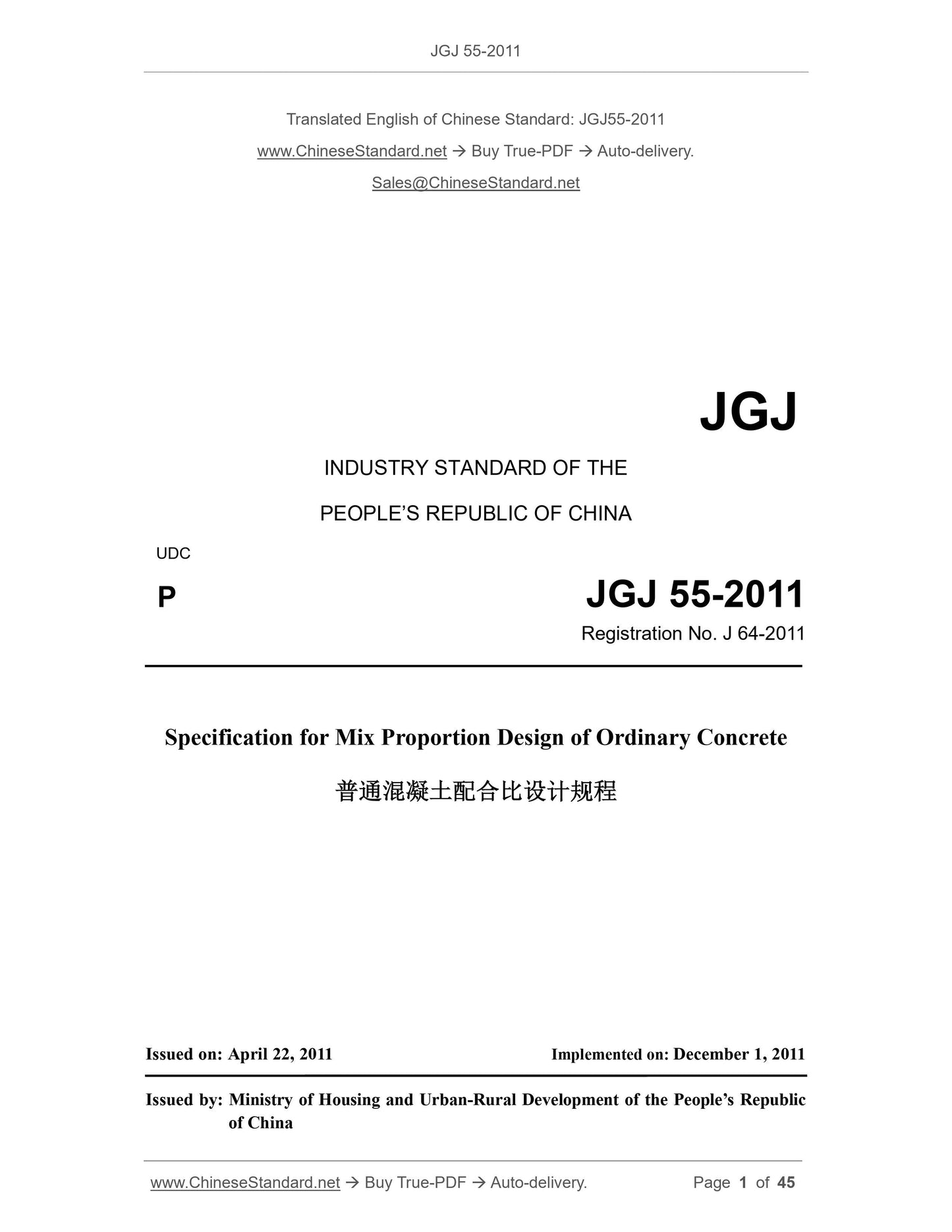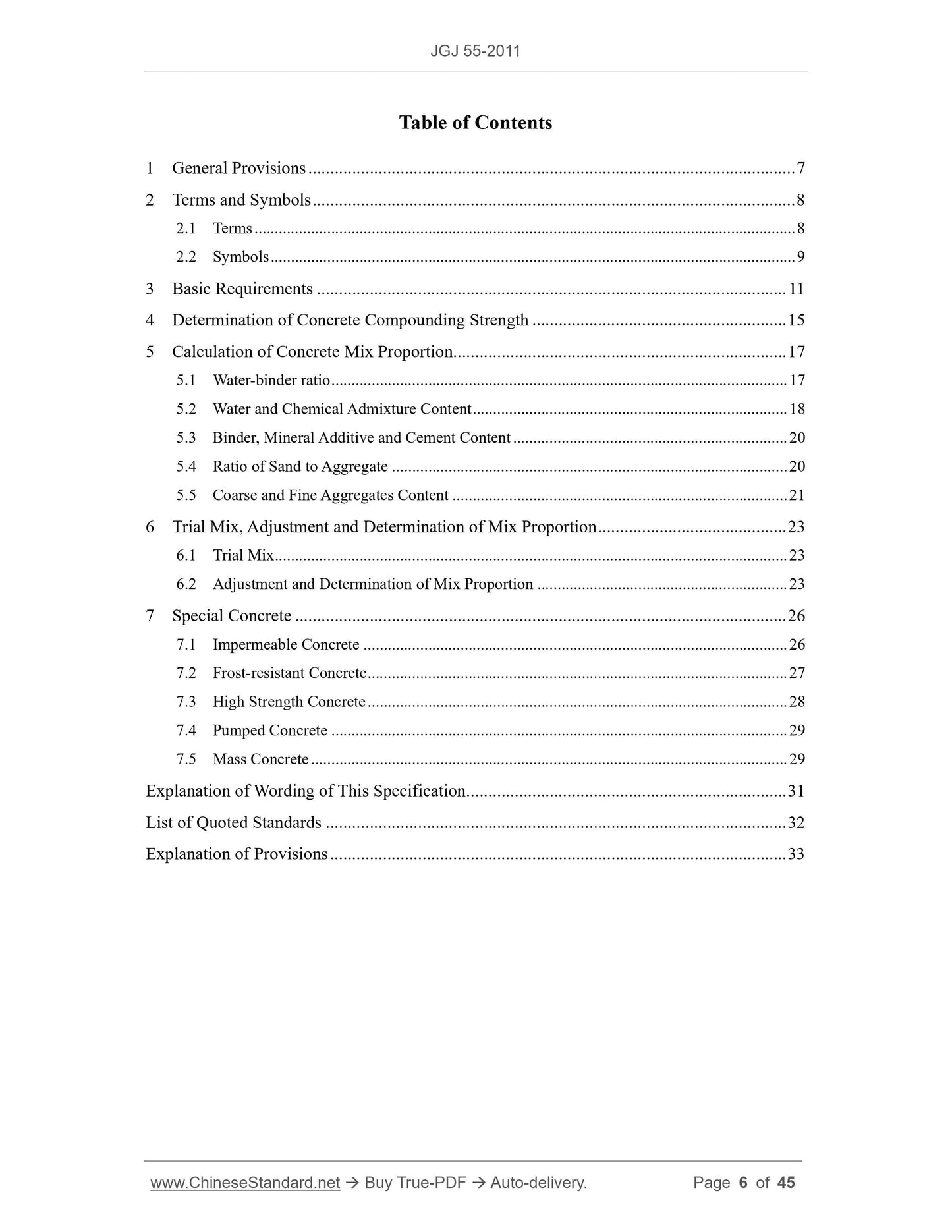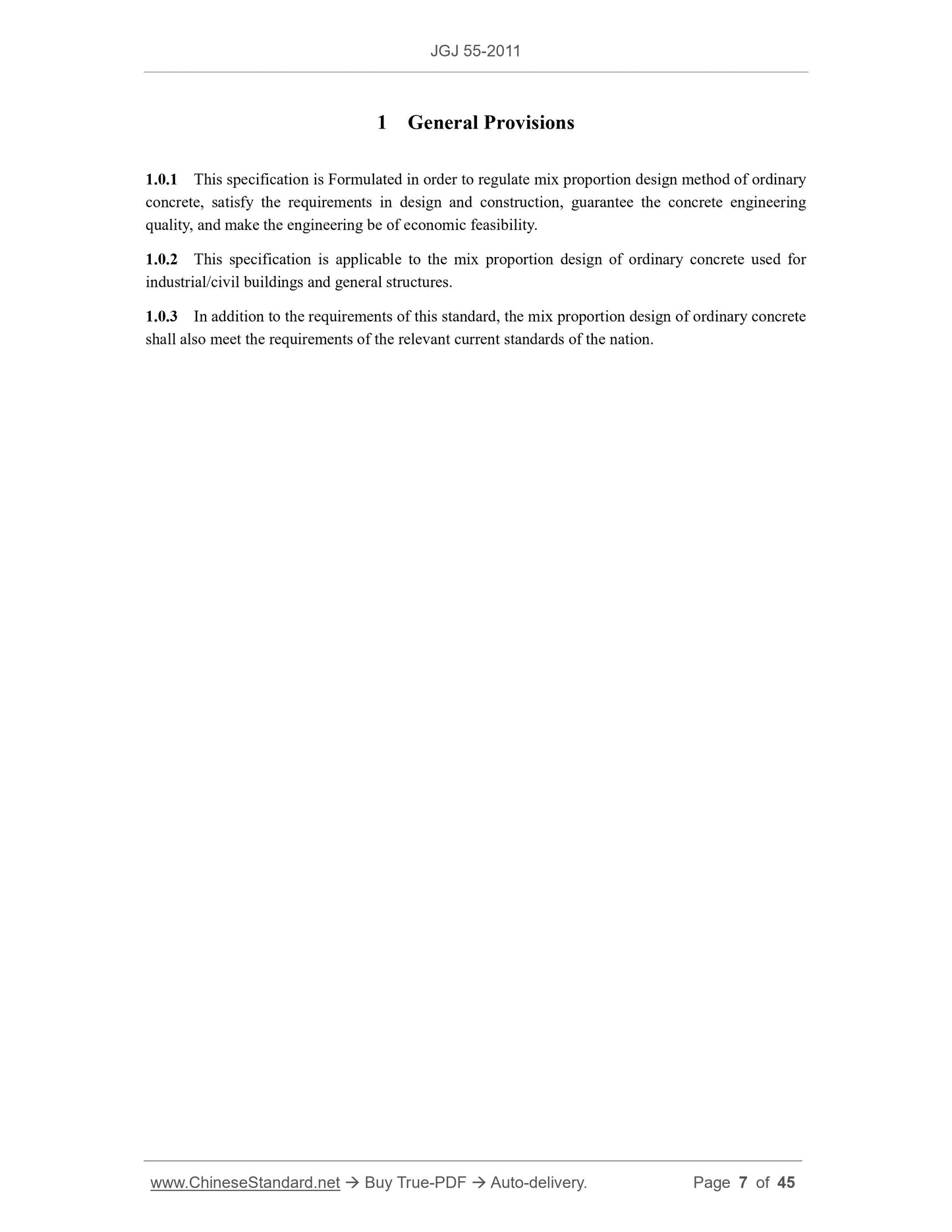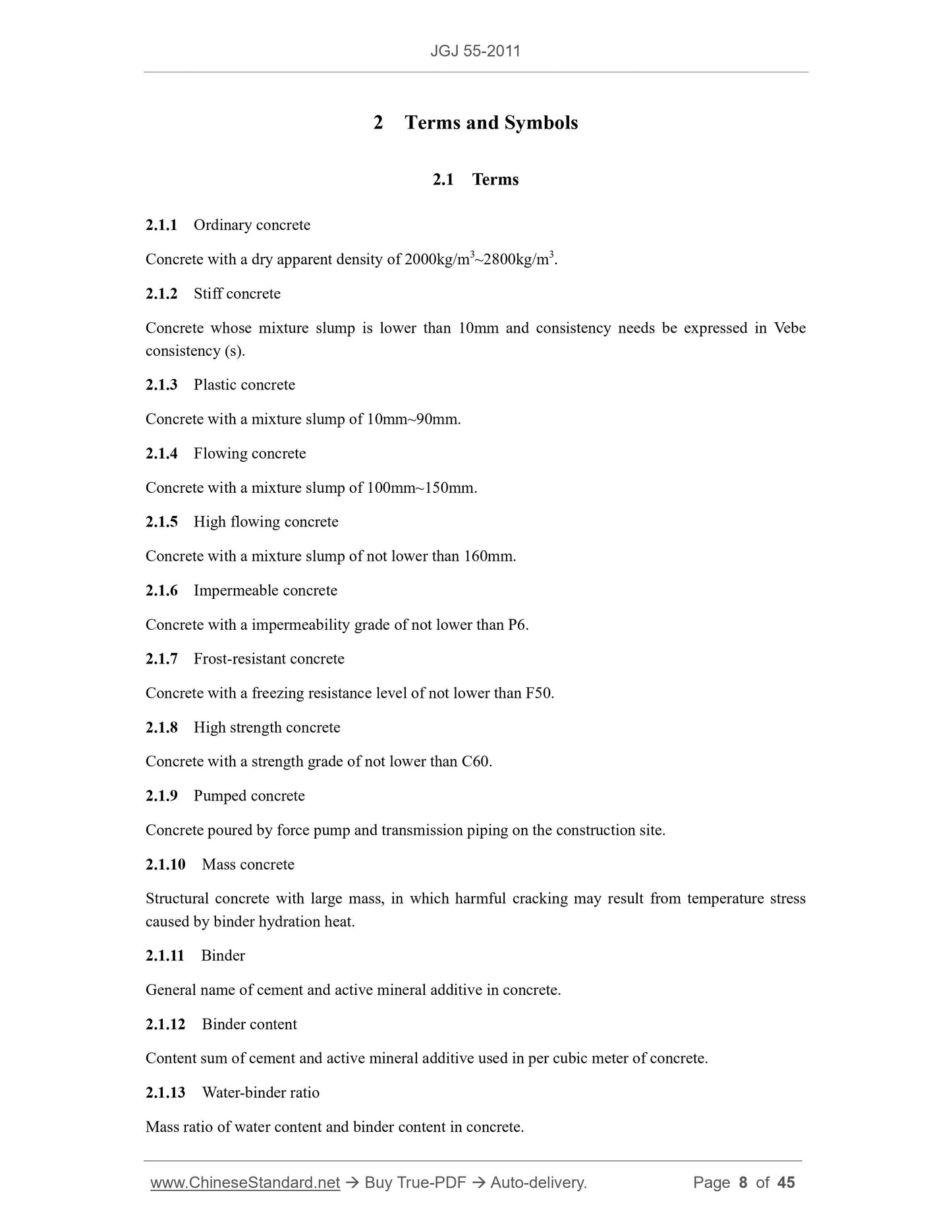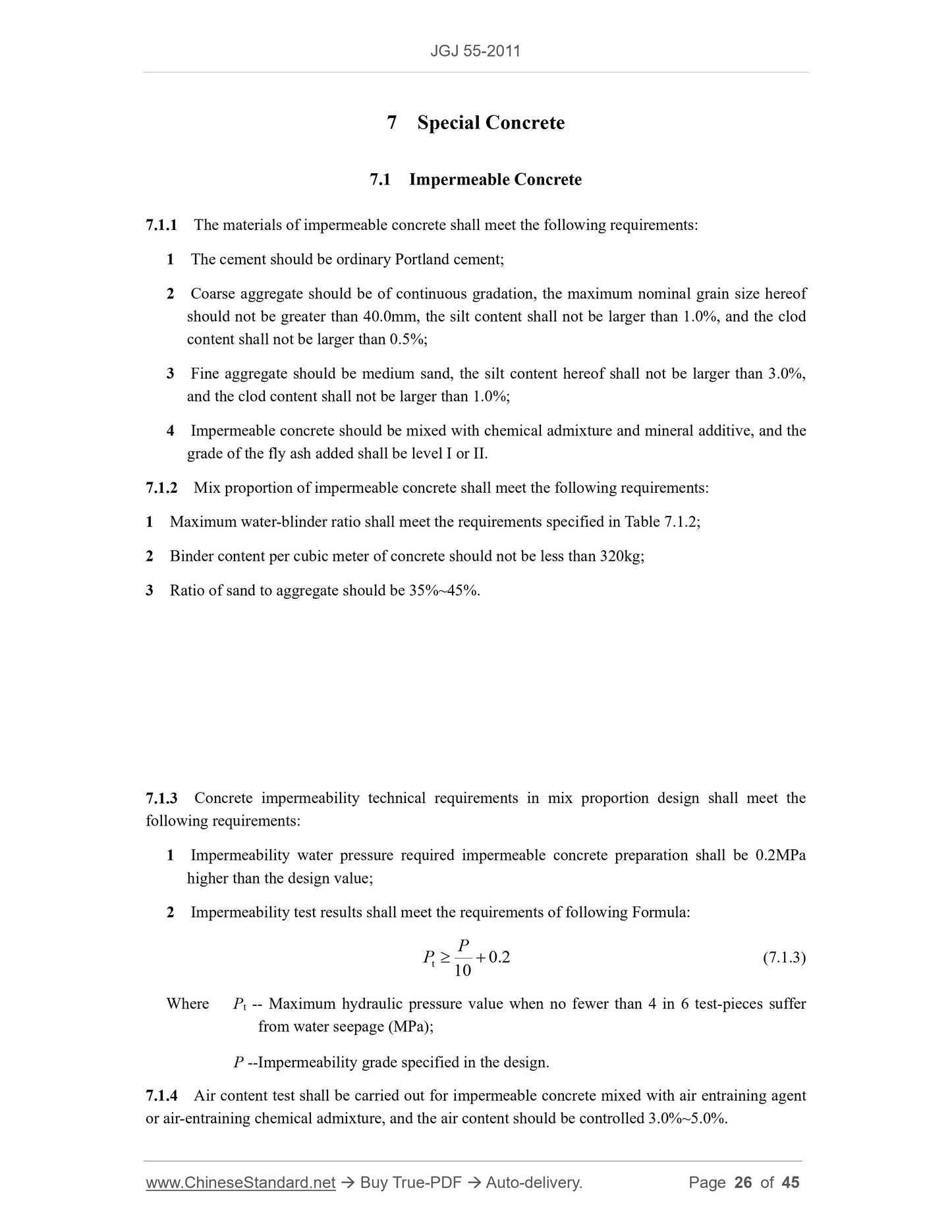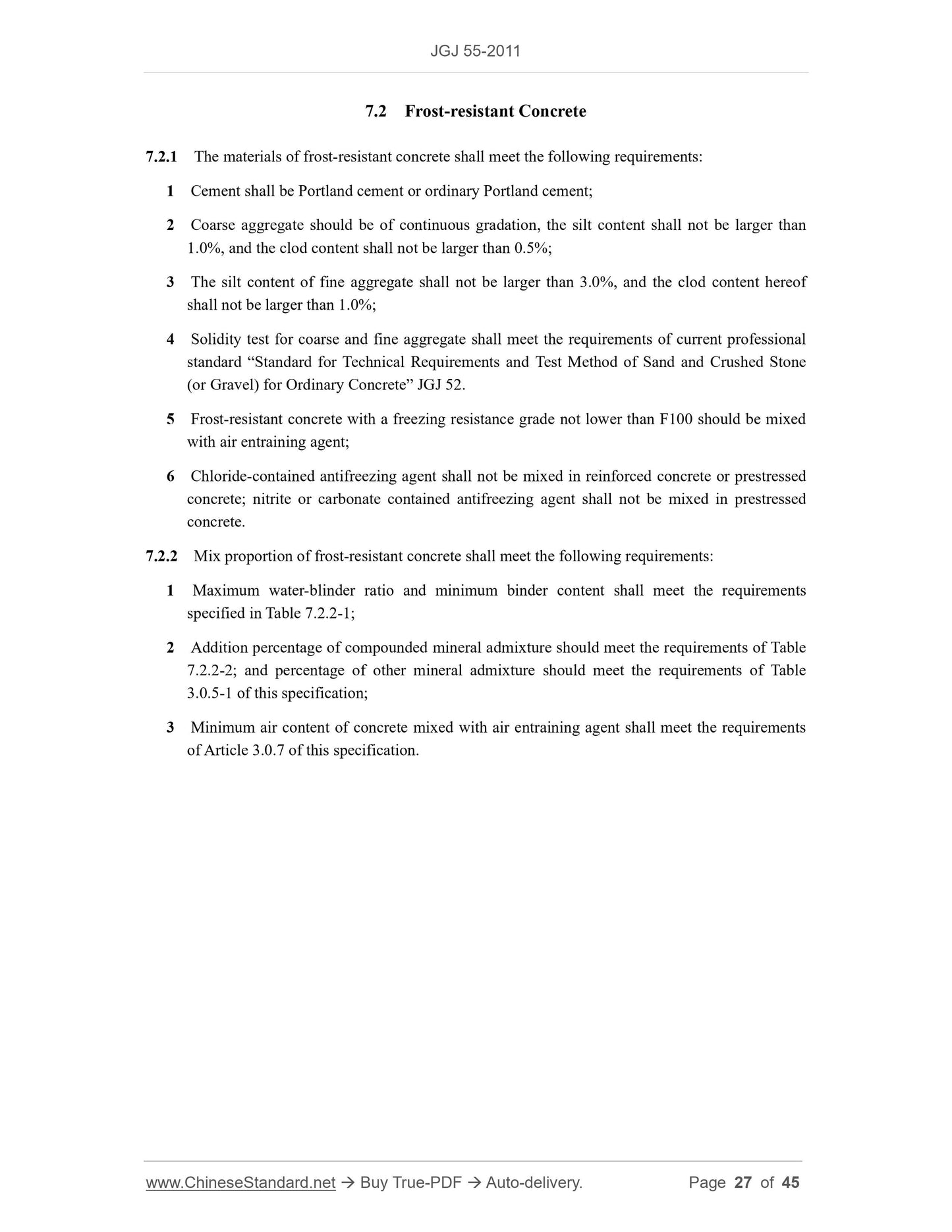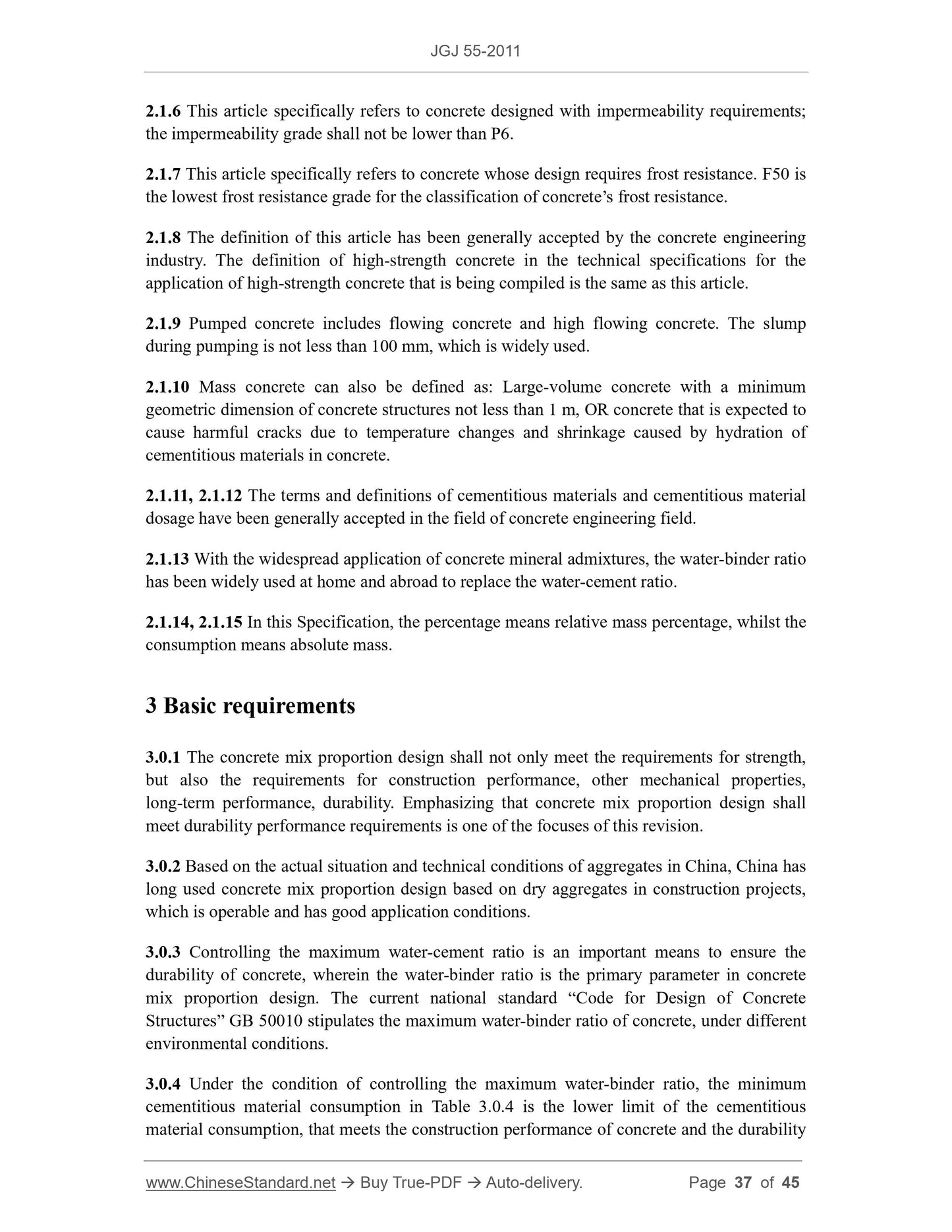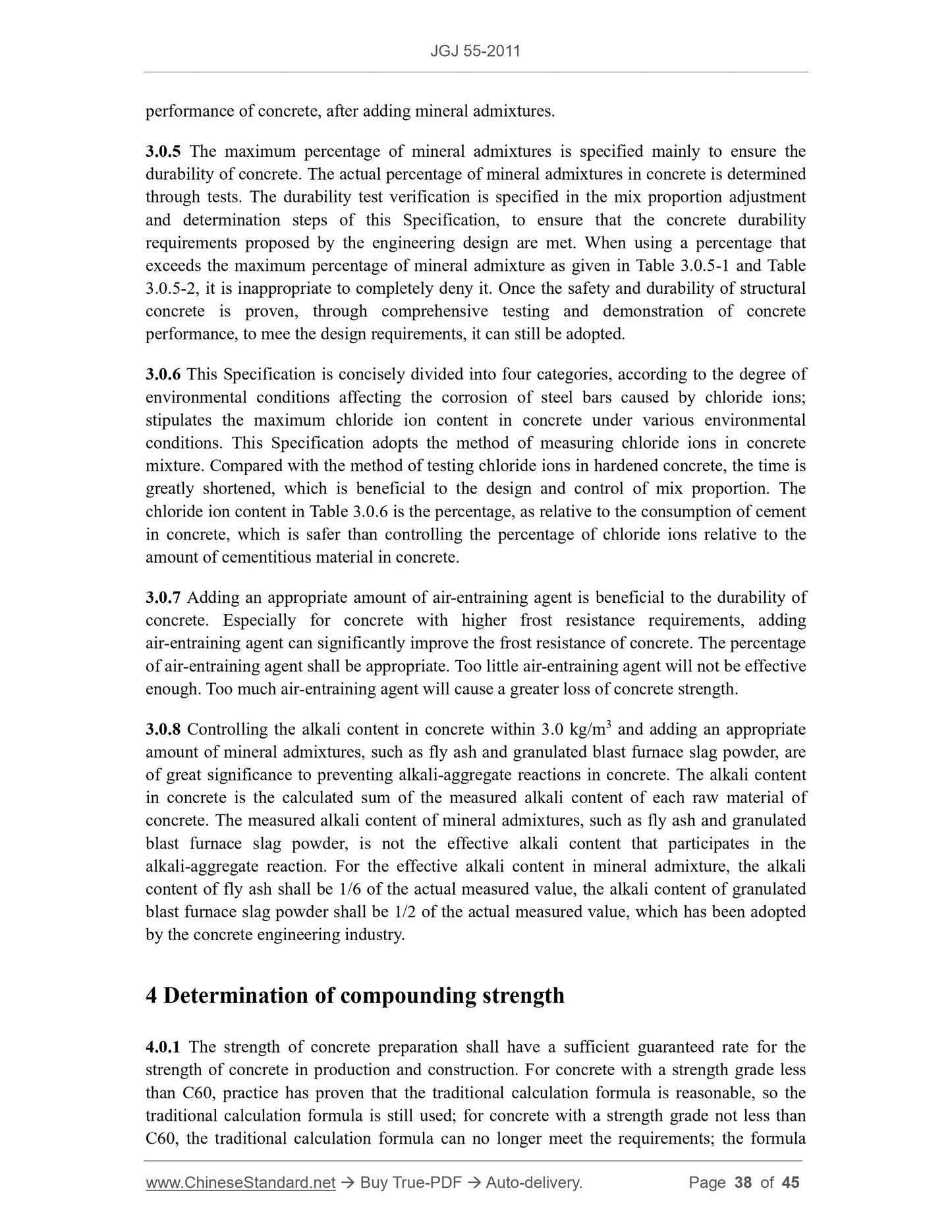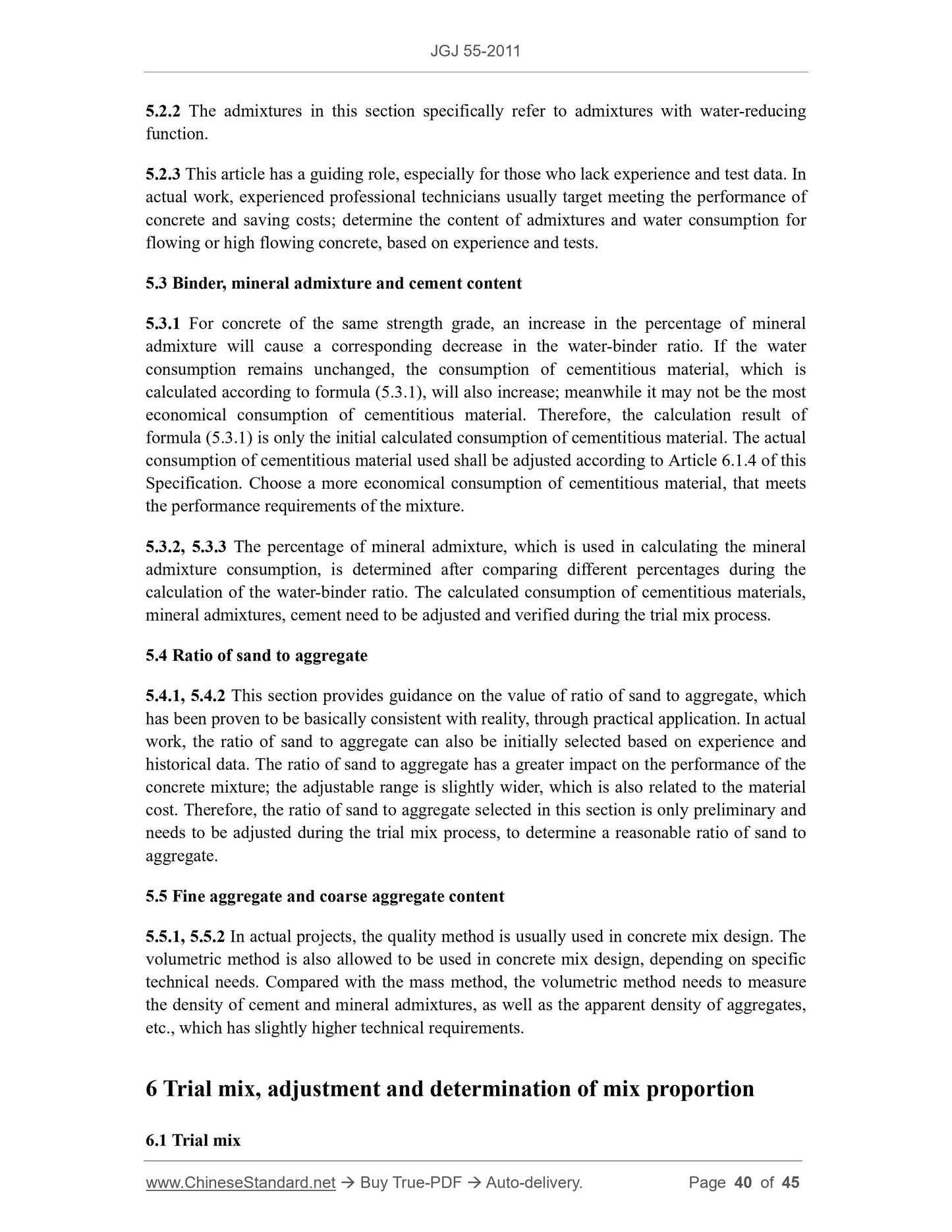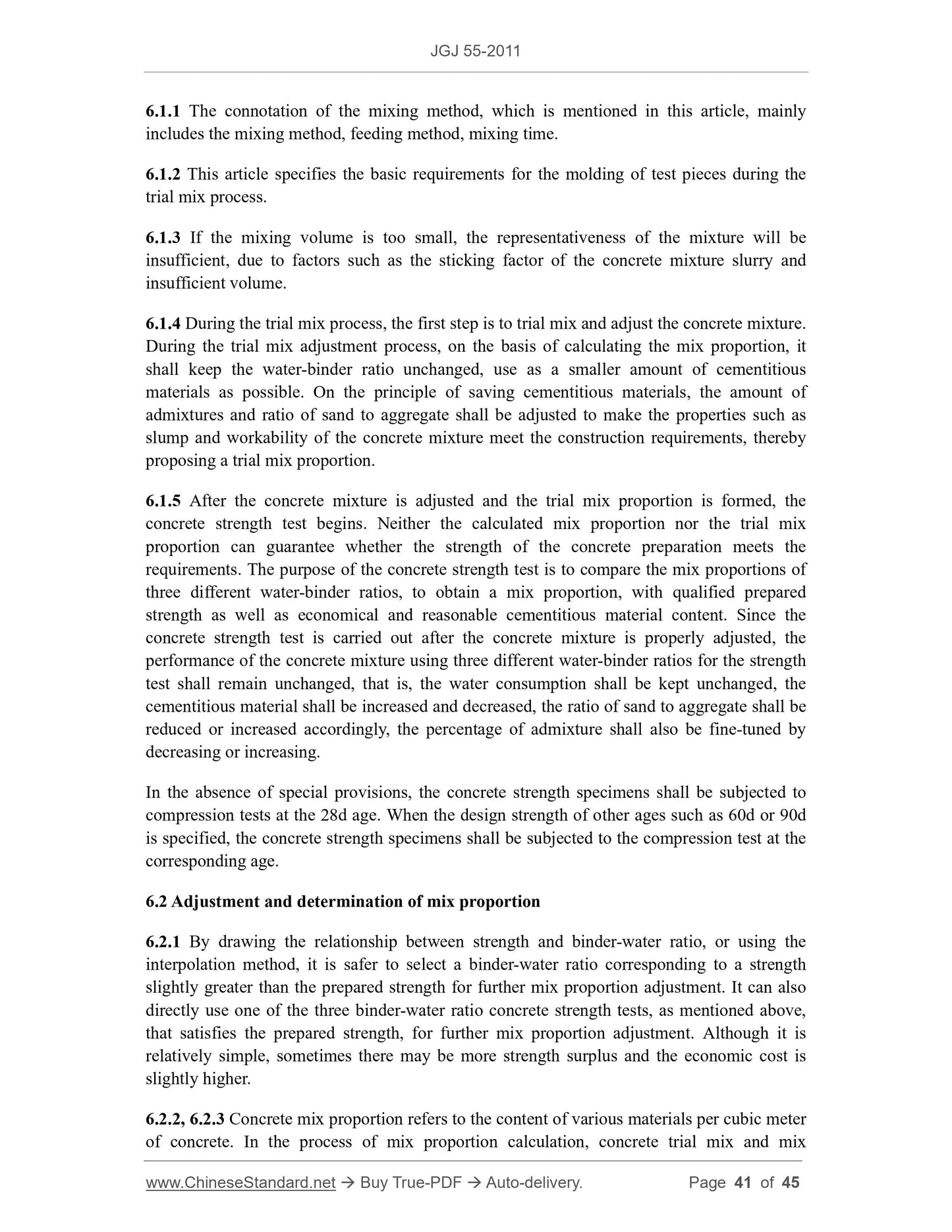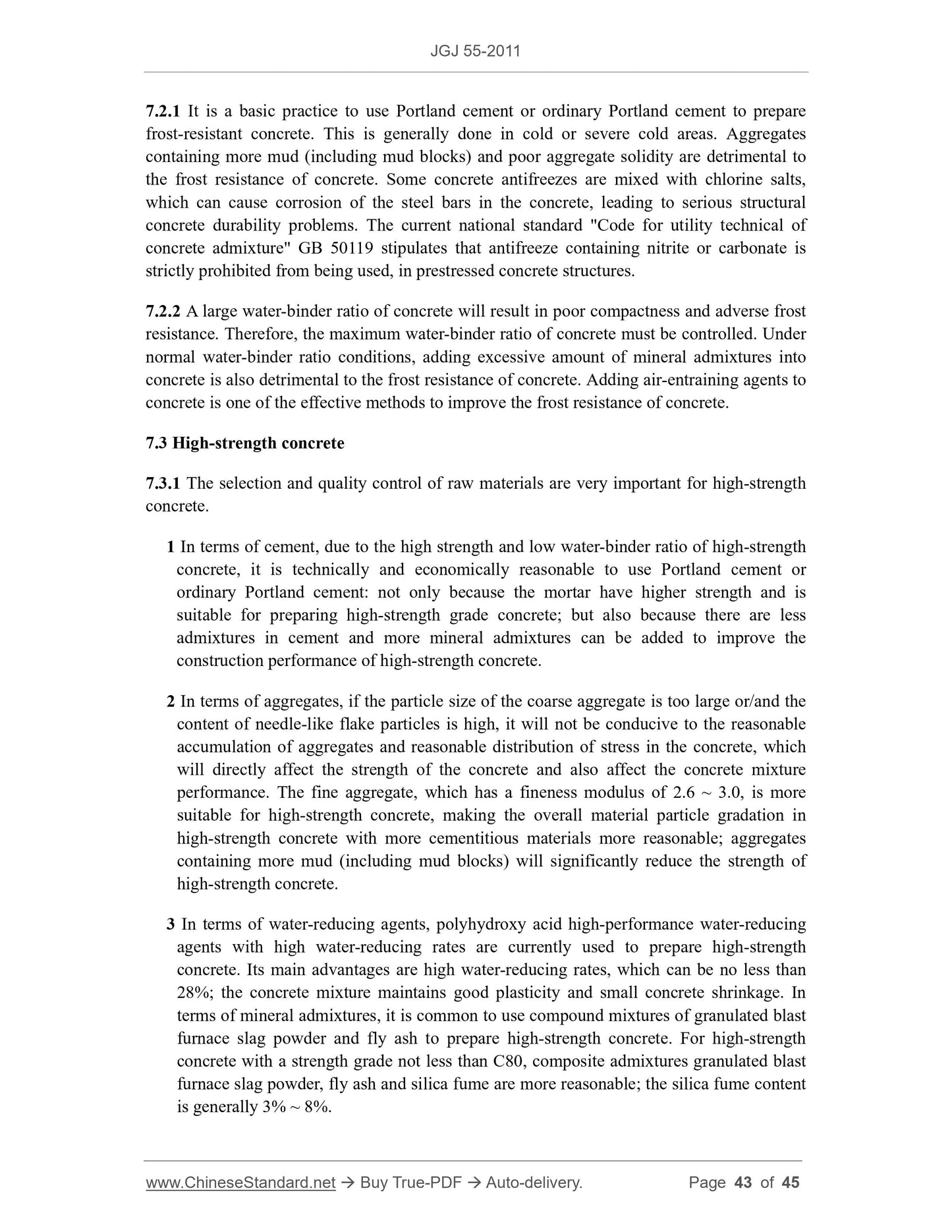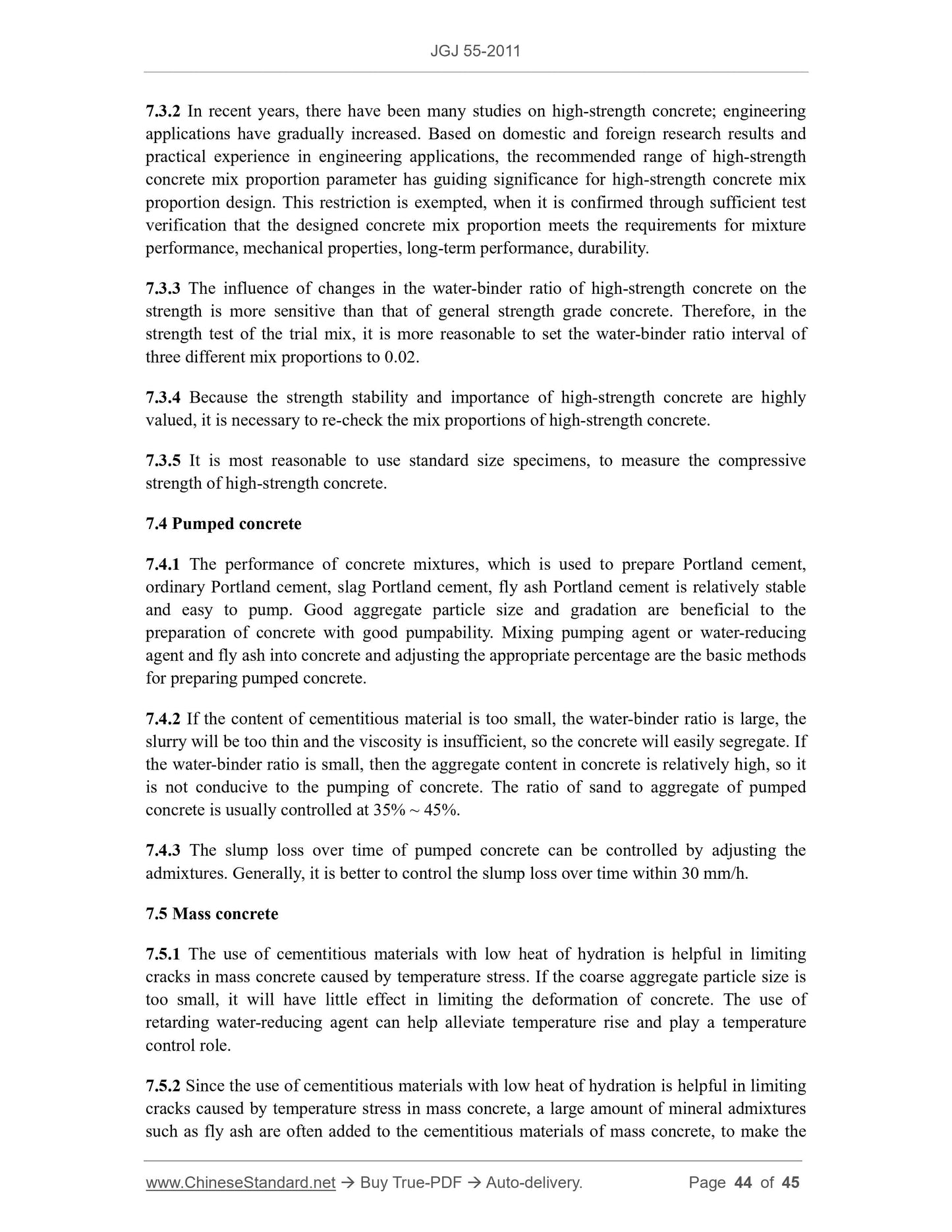1
/
of
12
PayPal, credit cards. Download editable-PDF and invoice in 1 second!
JGJ 55-2011 English PDF
JGJ 55-2011 English PDF
Regular price
$175.00 USD
Regular price
Sale price
$175.00 USD
Unit price
/
per
Shipping calculated at checkout.
Couldn't load pickup availability
Delivery: 3 seconds. Download true-PDF + Invoice.
Get QUOTATION in 1-minute: Click JGJ 55-2011
Historical versions: JGJ 55-2011
Preview True-PDF (Reload/Scroll if blank)
JGJ 55-2011: Specification for mix proportion design of ordinary concrete
JGJ 55-2011
JGJ
INDUSTRY STANDARD OF THE
PEOPLE’S REPUBLIC OF CHINA
UDC
P JGJ 55-2011
Registration No. J 64-2011
Specification for Mix Proportion Design of Ordinary Concrete
ISSUED ON: APRIL 22, 2011
IMPLEMENTED ON: DECEMBER 1, 2011
Issued by: Ministry of Housing and Urban-Rural Development of the People’s Republic
of China
Table of Contents
1 General Provisions ... 7
2 Terms and Symbols ... 8
2.1 Terms ... 8
2.2 Symbols ... 9
3 Basic Requirements ... 11
4 Determination of Concrete Compounding Strength ... 15
5 Calculation of Concrete Mix Proportion ... 17
5.1 Water-binder ratio ... 17
5.2 Water and Chemical Admixture Content ... 18
5.3 Binder, Mineral Additive and Cement Content ... 20
5.4 Ratio of Sand to Aggregate ... 20
5.5 Coarse and Fine Aggregates Content ... 21
6 Trial Mix, Adjustment and Determination of Mix Proportion ... 23
6.1 Trial Mix ... 23
6.2 Adjustment and Determination of Mix Proportion ... 23
7 Special Concrete ... 26
7.1 Impermeable Concrete ... 26
7.2 Frost-resistant Concrete ... 27
7.3 High Strength Concrete ... 28
7.4 Pumped Concrete ... 29
7.5 Mass Concrete ... 29
Explanation of Wording of This Specification ... 31
List of Quoted Standards ... 32
Explanation of Provisions ... 33
1 General Provisions
1.0.1 This specification is Formulated in order to regulate mix proportion design method of ordinary
concrete, satisfy the requirements in design and construction, guarantee the concrete engineering
quality, and make the engineering be of economic feasibility.
1.0.2 This specification is applicable to the mix proportion design of ordinary concrete used for
industrial/civil buildings and general structures.
1.0.3 In addition to the requirements of this standard, the mix proportion design of ordinary concrete
shall also meet the requirements of the relevant current standards of the nation.
2 Terms and Symbols
2.1 Terms
2.1.1 Ordinary concrete
Concrete with a dry apparent density of 2000kg/m3~2800kg/m3.
2.1.2 Stiff concrete
Concrete whose mixture slump is lower than 10mm and consistency needs be expressed in Vebe
consistency (s).
2.1.3 Plastic concrete
Concrete with a mixture slump of 10mm~90mm.
2.1.4 Flowing concrete
Concrete with a mixture slump of 100mm~150mm.
2.1.5 High flowing concrete
Concrete with a mixture slump of not lower than 160mm.
2.1.6 Impermeable concrete
Concrete with a impermeability grade of not lower than P6.
2.1.7 Frost-resistant concrete
Concrete with a freezing resistance level of not lower than F50.
2.1.8 High strength concrete
Concrete with a strength grade of not lower than C60.
2.1.9 Pumped concrete
Concrete poured by force pump and transmission piping on the construction site.
2.1.10 Mass concrete
Structural concrete with large mass, in which harmful cracking may result from temperature stress
caused by binder hydration heat.
2.1.11 Binder
General name of cement and active mineral additive in concrete.
2.1.12 Binder content
Content sum of cement and active mineral additive used in per cubic meter of concrete.
2.1.13 Water-binder ratio
Mass ratio of water content and binder content in concrete.
7 Special Concrete
7.1 Impermeable Concrete
7.1.1 The materials of impermeable concrete shall meet the following requirements:
1 The cement should be ordinary Portland cement;
2 Coarse aggregate should be of continuous gradation, the maximum nominal grain size hereof
should not be greater than 40.0mm, the silt content shall not be larger than 1.0%, and the clod
content shall not be larger than 0.5%;
3 Fine aggregate should be medium sand, the silt content hereof shall not be larger than 3.0%,
and the clod content shall not be larger than 1.0%;
4 Impermeable concrete should be mixed with chemical admixture and mineral additive, and the
grade of the fly ash added shall be level I or II.
7.1.2 Mix proportion of impermeable concrete shall meet the following requirements:
1 Maximum water-blinder ratio shall meet the requirements specified in Table 7.1.2;
2 Binder content per cubic meter of concrete should not be less than 320kg;
3 Ratio of sand to aggregate should be 35%~45%.
7.1.3 Concrete impermeability technical requirements in mix proportion design shall meet the
following requirements:
1 Impermeability water pressure required impermeable concrete preparation shall be 0.2MPa
higher than the design value;
2 Impermeability test results shall meet the requirements of following Formula:
2.010t
PP (7.1.3)
Where Pt -- Maximum hydraulic pressure value when no fewer than 4 in 6 test-pieces suffer
from water seepage (MPa);
P --Impermeability grade specified in the design.
7.1.4 Air content test shall be carried out for impermeable concrete mixed with air entraining agent
or air-entraining chemical admixture, and the air content should be controlled 3.0%~5.0%.
7.2 Frost-resistant Concrete
7.2.1 The materials of frost-resistant concrete shall meet the following requirements:
1 Cement shall be Portland cement or ordinary Portland cement;
2 Coarse aggregate should be of continuous gradation, the silt content shall not be larger than
1.0%, and the clod content shall not be larger than 0.5%;
3 The silt content of fine aggregate shall not be larger than 3.0%, and the clod content hereof
shall not be larger than 1.0%;
4 Solidity test for coarse and fine aggregate shall meet the requirements of current professional
standard “Standard for Technical Requirements and Test Method of Sand and Crushed Stone
(or Gravel) for Ordinary Concrete” JGJ 52.
5 Frost-resistant concrete with a freezing resistance grade not lower than F100 should be mixed
with air entraining agent;
6 Chloride-contained antifreezing agent shall not be mixed in reinforced concrete or prestressed
concrete; nitrite or carbonate contained antifreezing agent shall not be mixed in prestressed
concrete.
7.2.2 Mix proportion of frost-resistant concrete shall meet the following requirements:
1 Maximum water-blinder ratio and minimum binder content shall meet the requirements
specified in Table 7.2.2-1;
2 Addition percentage of compounded mineral admixture should meet the requirements of Table
7.2.2-2; and percentage of other mineral admixture should meet the requirements of Table
3.0.5-1 of this specification;
3 Minimum air content of concrete mixed with air entraining agent shall meet the requirements
of Article 3.0.7 of this specification.
2.1.6 This article specifically refers to concrete designed with impermeability requirements;
the impermeability grade shall not be lower than P6.
2.1.7 This article specifically refers to concrete whose design requires frost resistance. F50 is
the lowest frost resistance grade for the classification of concrete’s frost resistance.
2.1.8 The definition of this article has been generally accepted by the concrete engineering
industry. The definition of high-strength concrete in the technical specifications for the
application of high-strength concrete that is being compiled is the same as this article.
2.1.9 Pumped concrete includes flowing concrete and high flowing concrete. The slump
during pumping is not less than 100 mm, which is widely used.
2.1.10 Mass concrete can also be defined as: Large-volume concrete with a minimum
geometric dimension of concrete structures not less than 1 m, OR concrete that is expected to
cause harmful cracks due to temperature changes and sh...
Get QUOTATION in 1-minute: Click JGJ 55-2011
Historical versions: JGJ 55-2011
Preview True-PDF (Reload/Scroll if blank)
JGJ 55-2011: Specification for mix proportion design of ordinary concrete
JGJ 55-2011
JGJ
INDUSTRY STANDARD OF THE
PEOPLE’S REPUBLIC OF CHINA
UDC
P JGJ 55-2011
Registration No. J 64-2011
Specification for Mix Proportion Design of Ordinary Concrete
ISSUED ON: APRIL 22, 2011
IMPLEMENTED ON: DECEMBER 1, 2011
Issued by: Ministry of Housing and Urban-Rural Development of the People’s Republic
of China
Table of Contents
1 General Provisions ... 7
2 Terms and Symbols ... 8
2.1 Terms ... 8
2.2 Symbols ... 9
3 Basic Requirements ... 11
4 Determination of Concrete Compounding Strength ... 15
5 Calculation of Concrete Mix Proportion ... 17
5.1 Water-binder ratio ... 17
5.2 Water and Chemical Admixture Content ... 18
5.3 Binder, Mineral Additive and Cement Content ... 20
5.4 Ratio of Sand to Aggregate ... 20
5.5 Coarse and Fine Aggregates Content ... 21
6 Trial Mix, Adjustment and Determination of Mix Proportion ... 23
6.1 Trial Mix ... 23
6.2 Adjustment and Determination of Mix Proportion ... 23
7 Special Concrete ... 26
7.1 Impermeable Concrete ... 26
7.2 Frost-resistant Concrete ... 27
7.3 High Strength Concrete ... 28
7.4 Pumped Concrete ... 29
7.5 Mass Concrete ... 29
Explanation of Wording of This Specification ... 31
List of Quoted Standards ... 32
Explanation of Provisions ... 33
1 General Provisions
1.0.1 This specification is Formulated in order to regulate mix proportion design method of ordinary
concrete, satisfy the requirements in design and construction, guarantee the concrete engineering
quality, and make the engineering be of economic feasibility.
1.0.2 This specification is applicable to the mix proportion design of ordinary concrete used for
industrial/civil buildings and general structures.
1.0.3 In addition to the requirements of this standard, the mix proportion design of ordinary concrete
shall also meet the requirements of the relevant current standards of the nation.
2 Terms and Symbols
2.1 Terms
2.1.1 Ordinary concrete
Concrete with a dry apparent density of 2000kg/m3~2800kg/m3.
2.1.2 Stiff concrete
Concrete whose mixture slump is lower than 10mm and consistency needs be expressed in Vebe
consistency (s).
2.1.3 Plastic concrete
Concrete with a mixture slump of 10mm~90mm.
2.1.4 Flowing concrete
Concrete with a mixture slump of 100mm~150mm.
2.1.5 High flowing concrete
Concrete with a mixture slump of not lower than 160mm.
2.1.6 Impermeable concrete
Concrete with a impermeability grade of not lower than P6.
2.1.7 Frost-resistant concrete
Concrete with a freezing resistance level of not lower than F50.
2.1.8 High strength concrete
Concrete with a strength grade of not lower than C60.
2.1.9 Pumped concrete
Concrete poured by force pump and transmission piping on the construction site.
2.1.10 Mass concrete
Structural concrete with large mass, in which harmful cracking may result from temperature stress
caused by binder hydration heat.
2.1.11 Binder
General name of cement and active mineral additive in concrete.
2.1.12 Binder content
Content sum of cement and active mineral additive used in per cubic meter of concrete.
2.1.13 Water-binder ratio
Mass ratio of water content and binder content in concrete.
7 Special Concrete
7.1 Impermeable Concrete
7.1.1 The materials of impermeable concrete shall meet the following requirements:
1 The cement should be ordinary Portland cement;
2 Coarse aggregate should be of continuous gradation, the maximum nominal grain size hereof
should not be greater than 40.0mm, the silt content shall not be larger than 1.0%, and the clod
content shall not be larger than 0.5%;
3 Fine aggregate should be medium sand, the silt content hereof shall not be larger than 3.0%,
and the clod content shall not be larger than 1.0%;
4 Impermeable concrete should be mixed with chemical admixture and mineral additive, and the
grade of the fly ash added shall be level I or II.
7.1.2 Mix proportion of impermeable concrete shall meet the following requirements:
1 Maximum water-blinder ratio shall meet the requirements specified in Table 7.1.2;
2 Binder content per cubic meter of concrete should not be less than 320kg;
3 Ratio of sand to aggregate should be 35%~45%.
7.1.3 Concrete impermeability technical requirements in mix proportion design shall meet the
following requirements:
1 Impermeability water pressure required impermeable concrete preparation shall be 0.2MPa
higher than the design value;
2 Impermeability test results shall meet the requirements of following Formula:
2.010t
PP (7.1.3)
Where Pt -- Maximum hydraulic pressure value when no fewer than 4 in 6 test-pieces suffer
from water seepage (MPa);
P --Impermeability grade specified in the design.
7.1.4 Air content test shall be carried out for impermeable concrete mixed with air entraining agent
or air-entraining chemical admixture, and the air content should be controlled 3.0%~5.0%.
7.2 Frost-resistant Concrete
7.2.1 The materials of frost-resistant concrete shall meet the following requirements:
1 Cement shall be Portland cement or ordinary Portland cement;
2 Coarse aggregate should be of continuous gradation, the silt content shall not be larger than
1.0%, and the clod content shall not be larger than 0.5%;
3 The silt content of fine aggregate shall not be larger than 3.0%, and the clod content hereof
shall not be larger than 1.0%;
4 Solidity test for coarse and fine aggregate shall meet the requirements of current professional
standard “Standard for Technical Requirements and Test Method of Sand and Crushed Stone
(or Gravel) for Ordinary Concrete” JGJ 52.
5 Frost-resistant concrete with a freezing resistance grade not lower than F100 should be mixed
with air entraining agent;
6 Chloride-contained antifreezing agent shall not be mixed in reinforced concrete or prestressed
concrete; nitrite or carbonate contained antifreezing agent shall not be mixed in prestressed
concrete.
7.2.2 Mix proportion of frost-resistant concrete shall meet the following requirements:
1 Maximum water-blinder ratio and minimum binder content shall meet the requirements
specified in Table 7.2.2-1;
2 Addition percentage of compounded mineral admixture should meet the requirements of Table
7.2.2-2; and percentage of other mineral admixture should meet the requirements of Table
3.0.5-1 of this specification;
3 Minimum air content of concrete mixed with air entraining agent shall meet the requirements
of Article 3.0.7 of this specification.
2.1.6 This article specifically refers to concrete designed with impermeability requirements;
the impermeability grade shall not be lower than P6.
2.1.7 This article specifically refers to concrete whose design requires frost resistance. F50 is
the lowest frost resistance grade for the classification of concrete’s frost resistance.
2.1.8 The definition of this article has been generally accepted by the concrete engineering
industry. The definition of high-strength concrete in the technical specifications for the
application of high-strength concrete that is being compiled is the same as this article.
2.1.9 Pumped concrete includes flowing concrete and high flowing concrete. The slump
during pumping is not less than 100 mm, which is widely used.
2.1.10 Mass concrete can also be defined as: Large-volume concrete with a minimum
geometric dimension of concrete structures not less than 1 m, OR concrete that is expected to
cause harmful cracks due to temperature changes and sh...
Share
